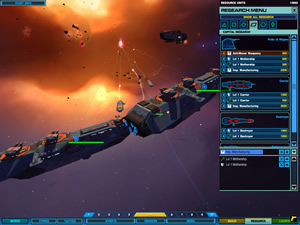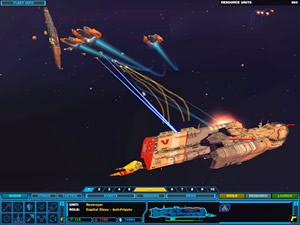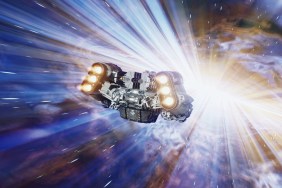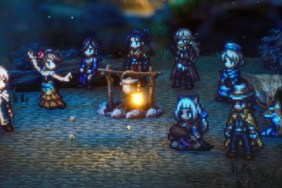Taking the long way home.
It has been four long years since I first led the desperate, hunted Kushans across
the galaxy to their homeworld, Hiigara, where they tried to live in peace. However,
the new Hiigarans only managed a century of relative calm before the galaxy came
knocking on their door once again. They are confronted with a new fearsome enemy,
the Vaygr, led by the legendary reincarnation of the Saajuk-Kahr.
Strange things are afoot in the universe, the time of prophecy is at hand,
and if you wish to fulfill your destiny or even just survive the dreaded Vaygr,
you must build a new mothership and follow the mysterious clues left by the
Progenitors in Vivendi and Relic’s new Homeworld 2.
Your new
mothership looks just like your old one, a massive boomerang of a capitol ship,
and is the center of your battle fleet. Many of the ships are also the same
as before; veteran commanders will be familiar with the all the fighters, bombers,
ion frigates, destroyers and others at your command.
In fact, almost every aspect of Homeworld 2 is identical
to the fantastic Homeworld. This is both a good
and a bad thing because Homeworld was a great game. But I was
really hoping for a little more innovation.
Despite an entirely updated game engine, the gameplay is mostly the same as
before. For those of you new to the series, Homeworld 2 is
a real-time strategy game that takes place in real 3D space. You mine asteroids
and destroyed ships for useful resources, which the game simplifies into a single
“resource unit,” and you use those resources to build more spaceships for your
fleet. Then you order your little ships around and get them to destroy the enemy.
It’s that “real 3D space” part that’s going to throw off a lot of novice gamers,
and is the first indicator of Homeworld 2‘s high level of difficulty.
Issuing move commands in a 3D environment it tricky to learn. The controls work
as well as anyone could expect them to, but right off the bat you will be confronted
with a learning curve steep enough to drive away most casual gamers. Homeworld
2 does make it a little easier than its predecessor by putting most
objects and targets on a single plane, but it’s still daunting.
There are two main changes in the gameplay, and neither one is very thrilling.
The first is that you can now target certain areas of capital ships (to disable
the engines or the fighter bay, for instance). This is a neat idea but isn’t
particularly useful, since if you can destroy a ship’s engines, you can probably
blow up the whole ship anyway. It also turns the capital ships into a mess of
multiple status bars cluttering the screen. Again, this is a good idea that
could just be implemented a little better.
The second is a restructuring of ship formations. Homeworld 2
divides the system into three AI stances: Passive, Neutral and Aggressive. You
now have the ability to group multiple classes of ships into three types of
battle groups that will move only as fast as the slowest ship in the group.
It’s a great idea on paper as it solves the classic RTS problem of quicker units
reaching their destination long before the slower ones. Unfortunately, these
changes have made the game less tactical, especially since the ships now tend
to break formation and fly “every man for himself” as soon as combat begins.
 Homeworld‘s
Homeworld‘s
graphics were innovative and impressive. The graphics in Homeworld 2,
while solid, are also surprisingly similar to the original. They’re certainly
improved, with new lighting effects and a higher level of detail, but the ship
models are noticeably blocky and some textures are strangely low-res when you
get in close. The fighters are oddly larger than before, especially in comparison
to the capital ships, which makes them easier to see but has the effect of making
those behemoth starships less impressive than before despite the increased detail.
[Author’s Note: One of the HW2 developers wrote in to explain
this. Apparently, you can shrink the fighters down to their proper size by turning
off the ‘NLIPS’ option in the menu. This stands for Non-Linear Inverse Perspective
Scaling and basically makes the fighters bigger so they are easier to see.]
Ship for ship, Homeworld 2 just can’t compare with recent
graphical space marvels like EVE Online,
but then again, no current game on the planet features anywhere near as many
ships simultaneously engaged in combat. This, of course, is the best-looking
part of Homeworld 2: the massive, chaotic, glorious space battles,
full of scrambling fighters, blasting turrets, tracking missiles and searing
ion beams. And when one of those ships goes down, the explosions are impressive
indeed.
The sound is equally stellar. The minimalist score fits the game perfectly,
and the voice acting both in-game and in the cut-scenes is top notch. But the
real sonic winner is once again the combat, with screaming ship engines, whooshing
torpedoes and blasting guns bringing the game to life. There is a palpable sense
of anticipation every time you hear your big progenitor ion cannon charging
up. You just can’t wait for that thing to go off and wreak havoc on an enemy
battleship.
Like the original Homeworld, it’s the plot that really carries
the game forward through the series of very difficult linear missions. The Vaygr
are truly menacing and I really became attached to my ragtag fleet of scrappy
underdogs, just like I did the first time I saw Battlestar
Galactica.
Despite losing the story, the multiplayer holds up nicely and supports up
to 6 people. With similar ship types on both sides of the conflict, however,
the game often comes down to a war of efficiency and resources rather than one
of strategic deployment.
The original Homeworld was a hard game, and the same can
be said for this sequel. Homeworld 2 is certainly one of the
harder games you’ll play all year, and amateur gamers should beware of this
title. But if you do not frustrate easily, you are assured many hours of gameplay
ahead of you.
It’s nice to have some Homeworld back on my computer and
a treat to have a whole new series of missions to play through, but I do wish
there had been a bit more after four years of waiting. It’s like rediscovering
a long lost friend, and while he’s still the same lovable guy, it turns out
he hasn’t matured much or traveled around Europe in the intervening years. He
simply never left home.

-
Solid delivery
-
Great battles
-
Engrossing plot
-
Really, really hard
-
Rough learning curve
-
Too much like the original











